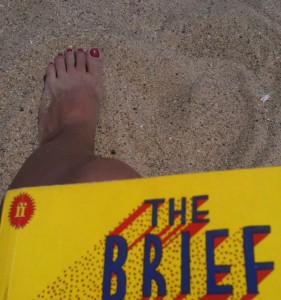Part of the new Presentation tips series
Adapted image, Aylam with Big Hand by Hanaan Rosenthal
While growing up I hated sand. Sand was just an annoying particle that stuck to everything when I went to the beach, my hair, my feet, my mouth…. One day, my former Pastor told us a story about sand. He described how the ancient tribes in the Old Testament would meet another tribe and mix sand from their land with sand from the other tribe’s land in a bag. The tribal leaders would then say, “When we separate each other’s sand that is when we will no longer be in agreement.” Each tribe kept that bag of sand for generations. In this case, sand became a bond of peace. I looked at sand much differently after this beautiful story. I began to smile at the amazing sculptures by children. Mixed with inspiration sand to them becomes something amazing and beautiful. It represents lands and fantasies in their minds. Sand is now one of my favorite particles. My favorite place to reflect is on a sandy beach. I love to sit on the sand, watch the waves, and think for hours. I have a ritual where I often listen to Sara Brightman’s Pie Jesu and dig my feet deep in the sand and count my blessings. Sand has become sacred to me when it was once annoying.

In the same way, technology is annoying to many educators and parents. Technology is everywhere and they see how enchanted children become with it instead of school, chores, or having family time. Part of presenting about technology or anything your audience will find annoying is to show them the possibilities. Show them how you allow students to create, collaborate, problem solve, and think critically with technology. Tell them the stories of children connecting with others worldwide.
We open eyes by sharing our stories.
The story is one of the most important pieces of any powerful presentation.
The Art of Storytelling
Anecdotes
The best way to learn how to effectively tell a story is to learn from great storytellers. One of my favorite podcasts is “This American Life” by Ira Glass. In this video, Ira Glass gives advice on anecdotes:
When you share a live story think about your voice, pitch, pauses, movement, hand and facial gestures. Think about ways to play with the story. Perform it in front of a mirror or video record yourself telling the story. Often it is best to memorize the story first then practice the gestures. Practice sharing your story with friends or family and monitor their reactions.
Perhaps you aren’t the best storyteller. Don’t worry your students are and when you can let them share their anecdotes about the instructional practice. A marriage counselor shared with me great advice, “Parents cannot stay angry at their children for too long because they’re blood but you they can stay angry at.”
Storytelling through Visuals
Image sequences that tell a story are also very powerful. Think about telling visual stories when crafting your presentation. This can be through slides or through a video you create or share.
Here’s a presentation that tells a story through images:
More Storytelling Resources
I’m certainly not the storytelling expert but hopefully you will find some of these resources useful:
- Effective Storytelling: A manual for beginners by Barry McWilliams
- YOU are a story absorber and a story teller by Andrew Wright.
- Several Video Storytelling Free Courses with Videos and Blog. The basic free course offers a lot of information but a warning that there is also a paid course.
- Storytelling Seminar Notes: Storytelling: The film-maker as storyteller
- Storytelling Seminar Notes: Storytelling: The art of the springboard story
- Ira Glass on Storytelling #2
- Ira Glass on Storytelling #3
Challenge:
Craft a story for your next presentation. Make it personal. If it touches you then the story will touch others.
You may want to subscribe for FREE to receive regular updates!
What are some of your favorite storytelling techniques?






